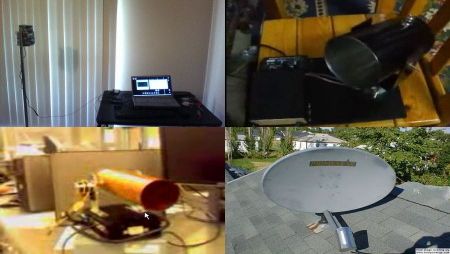Here is a classic project used to increase wireless signal strength. Cantennas focus using a waveguide very much like a magnifying glass focuses light. [Robert] made a Natural Light beer cantenna, pictured in the upper left. His approach used three beer cans, a paper towel holder, and a shower curtain rod. On the tipline, he noted a signal boost from 11Mbps to 54Mbps. This is certainly something we can hack together if our room lacks adequate signal. Read about parabolic and seeking versions after the break.
wifi469 Articles
Crack WEP Using BackTrack

Lifehacker wrote a guide for cracking a WiFi network’s WEP password using BackTrack. BackTrack is a Linux live CD used for security testing and comes with the tools needed to break WEP. Not just any wireless card will work for this; you need one that supports packet injection. The crack works by collecting legitimate packets then replaying them several times in order to generate data. They point out that this method can be hit-or-miss, especially if there are few other users on the network, as the crack requires authenticated packets. We covered cracking WEP before, but using BackTrack should smooth out compatibility issues.
Ekahau HeatMapper Maps Out WiFi Signals

The term ‘warwalking’ isn’t used very often, but the Ekahau HeatMapper adds a new tool to the pod bound hacker’s arsenal. The tool maps out wireless access points as well as their signal strength within a facility. A test of the HeatMapper on a map made with AutoDesk Dragonfly accurately determined the location of a router within 3 feet and helped tune the angle it needed to be at for maximum range. Ekahau made a fantastically cheesy promotional video for their product, which is viewable after the jump. The program is free of charge, but unfortunately only runs on windows, so mac and *nix users are out of luck, though it might run under wine.
D-Link Router Captcha Broken

We reported last week that D-Link was adding captchas to their routers to prevent automated login by malware. Unsurprisingly, it doesn’t work all time. The team from SourceSec grabbed the new firmware and began poking at it. They found that certain pages don’t require the authentication to be passed for access. One of these is WPS activation. WPS lets you do push button WPA configuration. Once activated, any nearby client can request the WPA key using a tool like WPSpy. Only user level credentials are needed to pull this off, so changing just the admin password won’t prevent it.
[photo: schoschie]
WiFi And Bluetooth Tethering On Android

Many G1/ADP1 owners have been using the app Tetherbot to get internet access on their laptop via USB to the phone’s data connection. The app relied on the Android Debug Bridge to forward ports. It worked, but people wanted a solution better than a SOCKS proxy. The community figured out a way to create a properly NAT’d connection using iptables and then [moussam] rolled them up into easy to use applications. There’s one for setting up a PAN device on Bluetooth and another for adhoc WiFi networking. It requires you to have root on your phone, but hopefully you’ve achieved that and are already running the latest community firmware.
[photo: tnkgrl]
WiFi Streaming Radio Update
[flickr video=3238566442]
Since our last post about his WiFi Streaming Radio Project, [Jeff] has been hard at work to release part 8 of the project where he adds tuning control to the radio. Interestingly enough, the addition of the tuning control only requires a potentiometer and the completed AVR LCD board from part 7. After wiring the potentiometer to the analog to digital converter on the AVR and adding a few lines of code, the radio can now be tuned quickly and easily. In addition to thoroughly explaining the hardware changes, [Jeff] details the configuration changes required to the OpenWRT framework so that bidirectional communication between the router and AVR is possible, allowing the tuner to function properly. Be sure to check out the video above to see the tuner in action.
Eye-Fi Teardown

[les robots] had a defective Eye-Fi card on his hands and when a replacement was sent, he was told to destroy the original. What better way to ‘destroy’ something than opening the case? The Eye-Fi is an SD card with a builtin WiFi radio so it can upload images while remaining in camera. One version uses Skyhook’s location service to geotag photos. You can see a few photos of the dismantled card on Flickr. The board is manufactured by Wintec. The wireless side is handled by Atheros’ ROCm, the same low power Radio-on-Chip module you would find in a mobile phone. The flash memory comes from Samsung and the antenna is along the back edge, where it has the best chance of getting signal.











